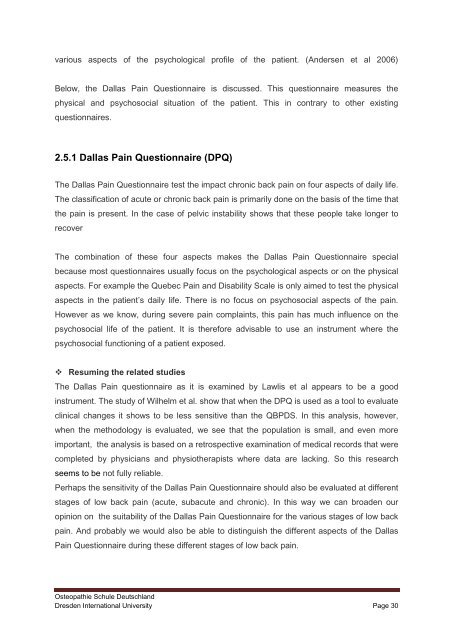Pelvic girdle pain and relevance of ASLR testing: A ... - Cindy Verheul
Pelvic girdle pain and relevance of ASLR testing: A ... - Cindy Verheul
Pelvic girdle pain and relevance of ASLR testing: A ... - Cindy Verheul
Create successful ePaper yourself
Turn your PDF publications into a flip-book with our unique Google optimized e-Paper software.
various aspects <strong>of</strong> the psychological pr<strong>of</strong>ile <strong>of</strong> the patient. (Andersen et al 2006)<br />
Below, the Dallas Pain Questionnaire is discussed. This questionnaire measures the<br />
physical <strong>and</strong> psychosocial situation <strong>of</strong> the patient. This in contrary to other existing<br />
questionnaires.<br />
2.5.1 Dallas Pain Questionnaire (DPQ)<br />
The Dallas Pain Questionnaire test the impact chronic back <strong>pain</strong> on four aspects <strong>of</strong> daily life.<br />
The classification <strong>of</strong> acute or chronic back <strong>pain</strong> is primarily done on the basis <strong>of</strong> the time that<br />
the <strong>pain</strong> is present. In the case <strong>of</strong> pelvic instability shows that these people take longer to<br />
recover<br />
The combination <strong>of</strong> these four aspects makes the Dallas Pain Questionnaire special<br />
because most questionnaires usually focus on the psychological aspects or on the physical<br />
aspects. For example the Quebec Pain <strong>and</strong> Disability Scale is only aimed to test the physical<br />
aspects in the patient’s daily life. There is no focus on psychosocial aspects <strong>of</strong> the <strong>pain</strong>.<br />
However as we know, during severe <strong>pain</strong> complaints, this <strong>pain</strong> has much influence on the<br />
psychosocial life <strong>of</strong> the patient. It is therefore advisable to use an instrument where the<br />
psychosocial functioning <strong>of</strong> a patient exposed.<br />
Resuming the related studies<br />
The Dallas Pain questionnaire as it is examined by Lawlis et al appears to be a good<br />
instrument. The study <strong>of</strong> Wilhelm et al. show that when the DPQ is used as a tool to evaluate<br />
clinical changes it shows to be less sensitive than the QBPDS. In this analysis, however,<br />
when the methodology is evaluated, we see that the population is small, <strong>and</strong> even more<br />
important, the analysis is based on a retrospective examination <strong>of</strong> medical records that were<br />
completed by physicians <strong>and</strong> physiotherapists where data are lacking. So this research<br />
seems to be not fully reliable.<br />
Perhaps the sensitivity <strong>of</strong> the Dallas Pain Questionnaire should also be evaluated at different<br />
stages <strong>of</strong> low back <strong>pain</strong> (acute, subacute <strong>and</strong> chronic). In this way we can broaden our<br />
opinion on the suitability <strong>of</strong> the Dallas Pain Questionnaire for the various stages <strong>of</strong> low back<br />
<strong>pain</strong>. And probably we would also be able to distinguish the different aspects <strong>of</strong> the Dallas<br />
Pain Questionnaire during these different stages <strong>of</strong> low back <strong>pain</strong>.<br />
Osteopathie Schule Deutschl<strong>and</strong><br />
Dresden International University Page 30


